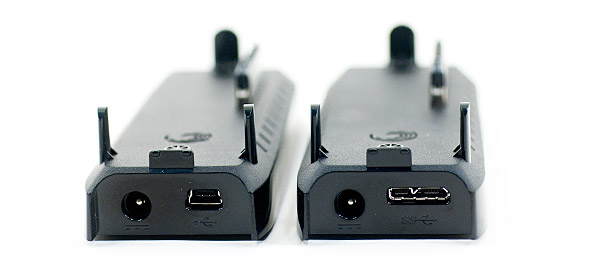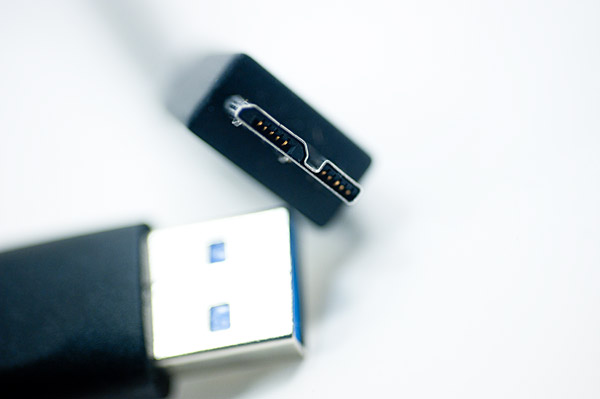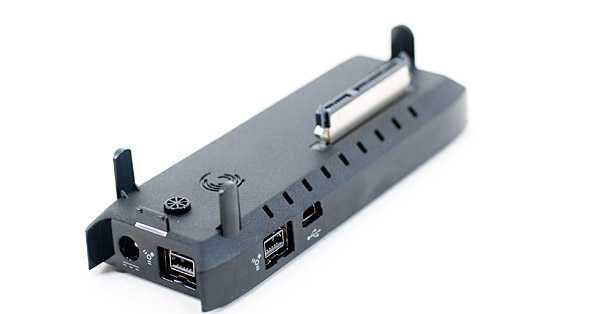The World's First 3TB HDD: Seagate GoFlex Desk 3TB Review
by Anand Lal Shimpi on August 23, 2010 12:39 AM EST- Posted in
- Storage
- Seagate
- HDDs
- GoFlex Desk
USB 2.0, 3.0 and FireWire 800 Performance
Seagate sent all three docks for review and I benchmarked the 3TB GoFlex Desk under both Windows 7 and Mac OS X 10.6.4 to get an idea for its performance. The full results are below, but I’ll give you the gist of it here.

USB 2.0 and USB 3.0 docks (left and right)
Over USB 2.0 I got around 30MB/s for sequential reads/writes. That’s 240Mbps, about half of the USB 2.0 spec maximum.
| Windows Performance Comparison | |||||
| Seagate GoFlex Desk 3TB (USB 2.0) | Seagate GoFlex Desk 3TB (USB 3.0) | ||||
| Sequential Read | 33.1 MB/s | 151.9 MB/s | |||
| Sequential Write | 26.9 MB/s | 151.2 MB/s | |||
| Random Read | 0.30 MB/s | 0.30 MB/s | |||
| Random Write | 0.93 MB/s | 0.93 MB/s | |||
USB 3.0 performance is just awesome, the drive performs just like an internal hard drive. It's a shame that USB 3.0 isn't more ubiquitous because this is great performance not to mention that you get backwards compatibility with USB 2.0 systems. The only issue is you need to make sure you don't lose the USB 3.0 cable since the drive-end of it is not backwards compatible.
I actually got better performance over USB 3.0 than I did with the drive connected via SATA at around 150MB/s for sequential reads/writes. The SATA to USB 3.0 bridge does some additional buffering that may be the cause of the improved performance here. Random performance remained unchanged regardless of what interface I used.

The USB 3.0 cable that ships with the GoFlex Desk USB 3.0 dock. It works in both USB 2.0 and USB 3.0 ports.
On the Mac, without Iometer I had to resort to XBench for the performance numbers. All of these are written via the filesystem but are uncached:
| Mac Performance Comparison - XBench 1.3 | |||||
| Seagate GoFlex Desk 3TB (USB 2.0) | Seagate GoFlex Desk 3TB (FireWire 800) | ||||
| Sequential Read | 17.0 MB/s | 74.9 MB/s | |||
| Sequential Write | 15.8 MB/s | 47.6 MB/s | |||
| Random Read | 0.68 MB/s | 0.73 MB/s | |||
| Random Write | 1.80 MB/s | 1.78 MB/s | |||
USB 2.0 performance was aroun 15 - 17MB/s while FireWire 800 managed 47.6MB/s for sequential writes and 75MB/s for sequential reads. Copying files to the drive manually I saw very similar numbers over FireWire 800 (53MB/s writes, 78MB/s reads). Note that performance was identical regardless of whether I was using Paragon’s NTFS driver or I formatted the drive in OS X’s native HFS+ file format.

FireWire 800
What this tells us is that, at least compared to FireWire 800 on a Mac Pro, the USB 3 connection in Windows is still the quickest way to write to the drive. There is one more stipulation that I must bring up. Most mainstream motherboards with an Intel chipset don’t give USB 3 controllers enough bandwidth to deliver these sorts of results. I was using a Gigabyte X58A-UD5, but many other boards dangle the USB 3 controller off of a single PCIe x1 lane running at 250MB/s (250MB/s each direction). In these cases you’ll still get better than USB 2.0 performance but you may not see the same numbers I got here.
I wrote about this issue while talking about 6Gbps SATA controllers on Intel motherboards here, but the same problem documented in that article applies to USB 3.0.










81 Comments
View All Comments
zdzichu - Monday, August 23, 2010 - link
In first performance table you switched results for SATA and USB3.0 of 3TB drive.oc3an - Monday, August 23, 2010 - link
The maximum integer which can be represented with 32 bits is 4294967295 i.e. 2^32 - 1 which allows for 4294967296 values. The article is worded incorrectly.mino - Monday, August 23, 2010 - link
"...so the largest partition you can have in a MBR partitioned drive is 4294967296 * 512-bytes or 2,199,023,255,552 bytes..."Are you sure that is an incorrect wording?
mino - Monday, August 23, 2010 - link
BIOS does support booting from GPT.It is the Windows boot loader that cannot boot from GPT on BIOS systems.
As a matter of fact I am writing this from Gigabyte 780G board running Ubuntu 10.04 on top of GPT(on top of LVM on top of MD on top of GPT).
yuhong - Monday, August 23, 2010 - link
To be more precise, all that BIOS does is read the first sector of the drive, check for the signature at the end, and if it matches, then it jumps to the real mode x86 code at the beginning. It is actually partition scheme agnostic. Now some BIOSes are not quite partition scheme agnostic and will rely on the contents of the first sector being in the MBR format, luckily GPT support a protective MBR.baker269 - Monday, August 23, 2010 - link
I would love to see what the Ethernet speeds are like. Not that great I would guess since it's not a true NAS, but still would be nice.mindless1 - Monday, August 23, 2010 - link
?? It doesn't have an ethernet interface does it? Speeds would be similar enough to any current-gen 7200 RPM drive already in a system on your LAN.baker269 - Tuesday, August 24, 2010 - link
From the forth paragraph of the article."The drives themselves are standard 3.5” hard drives in a plastic enclosure designed to mate with GoFlex Desk adapters that add USB 2.0, USB 3.0, FireWire 800 or Ethernet connectivity to the drive."
It"s not as easy as just plugging in a hard drive with a RJ45 to a router, there needs to be some kind of CPU in between the two. NAS performance through Ethernet varies greatly.
derkurt - Monday, August 23, 2010 - link
Is it such a big deal that Windows doesn't boot from GPT drives if the BIOS is not EFI-capable? Whoever spends 400+ USD on a drive probably just needs lots of storage space for plain data. It's unlikely that there is no fast boot drive present in any system this drive is plugged into. Actually, since the first expansive 3 TB drives are bought by enthusiasts, chances are that the customers are already using an SSD as a boot drive.That said, in a realistic setting for a performance workstation with Windows 7 x64 installed on a 80+ GB SSD, there won't be a problem. You can connect the drive to the internal SATA connector, partition it with GPT and start using it, while your BIOS doesn't need to know anything about EFI or GPT. The heat issues might also look better when using the drive internally.
I don't understand why Seagate is holding back with selling the internal model. An estimated 95% of users will never even try to boot from it, and for the rest (who do want to boot from it but don't know about the 2+ TB issues), there could be a red warning note inside the box explaining the juicy details. After all, those who spend such an amount of money on a hard drive are not exactly the kind of people who have no clue about hard drives at all.
dryloch - Monday, August 23, 2010 - link
One of Seagates biggest advantages has been that their external hard drives come with a 5 year warranty. Why would they go to a two year warranty on the most expensive drive they sell? If anything they should have at least gone with three years. If they don't even trust this drive then I sure won't. I'll be waiting for Western Digital to have their drive out.